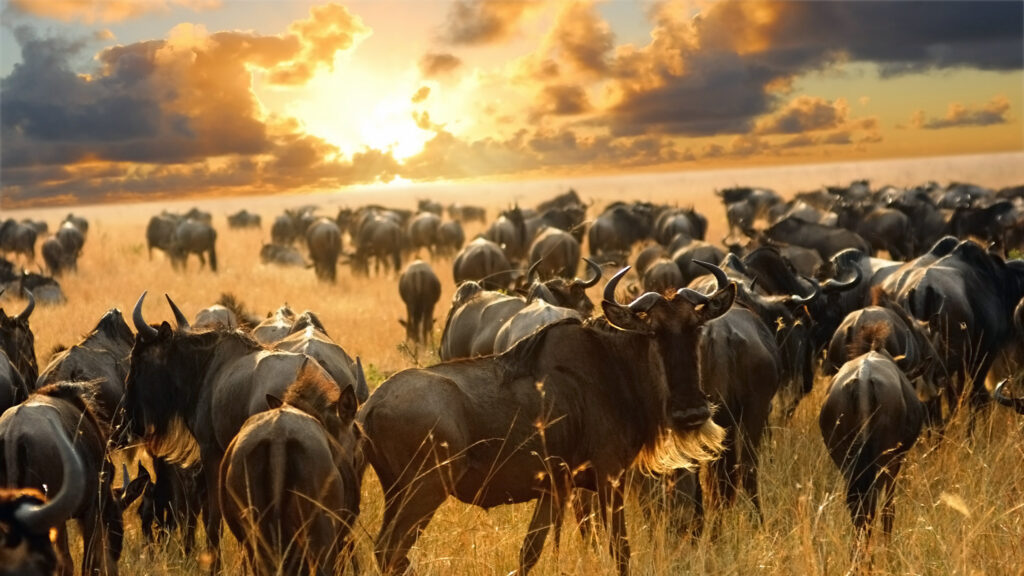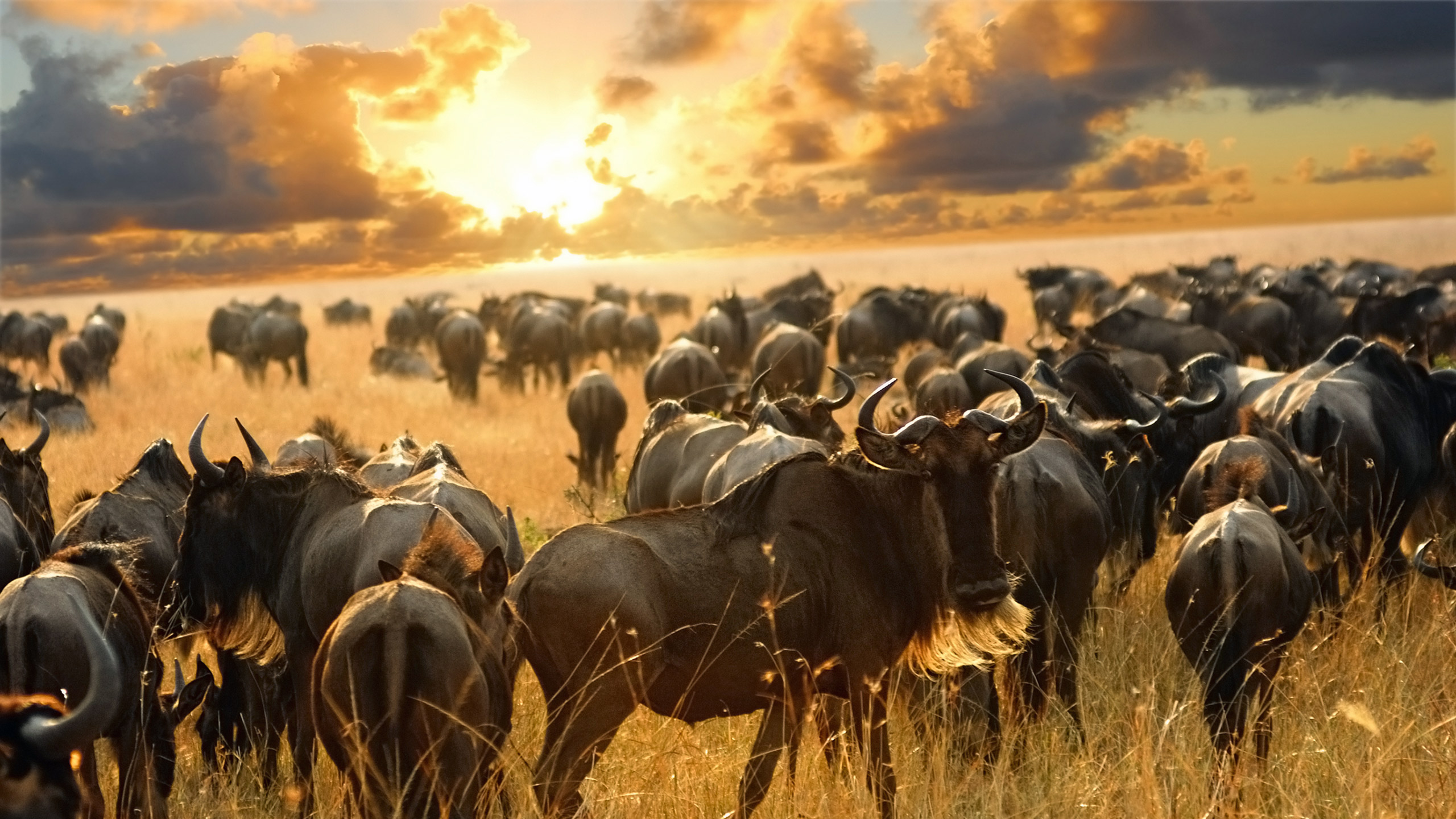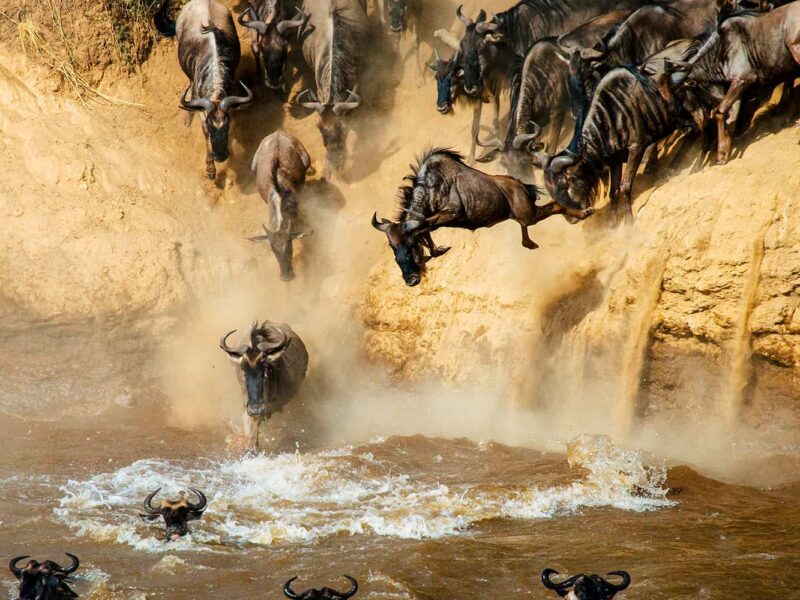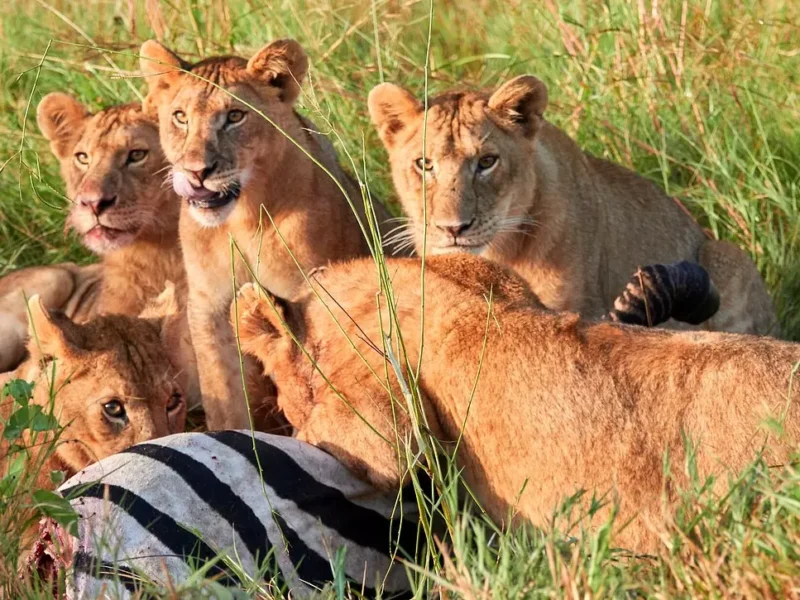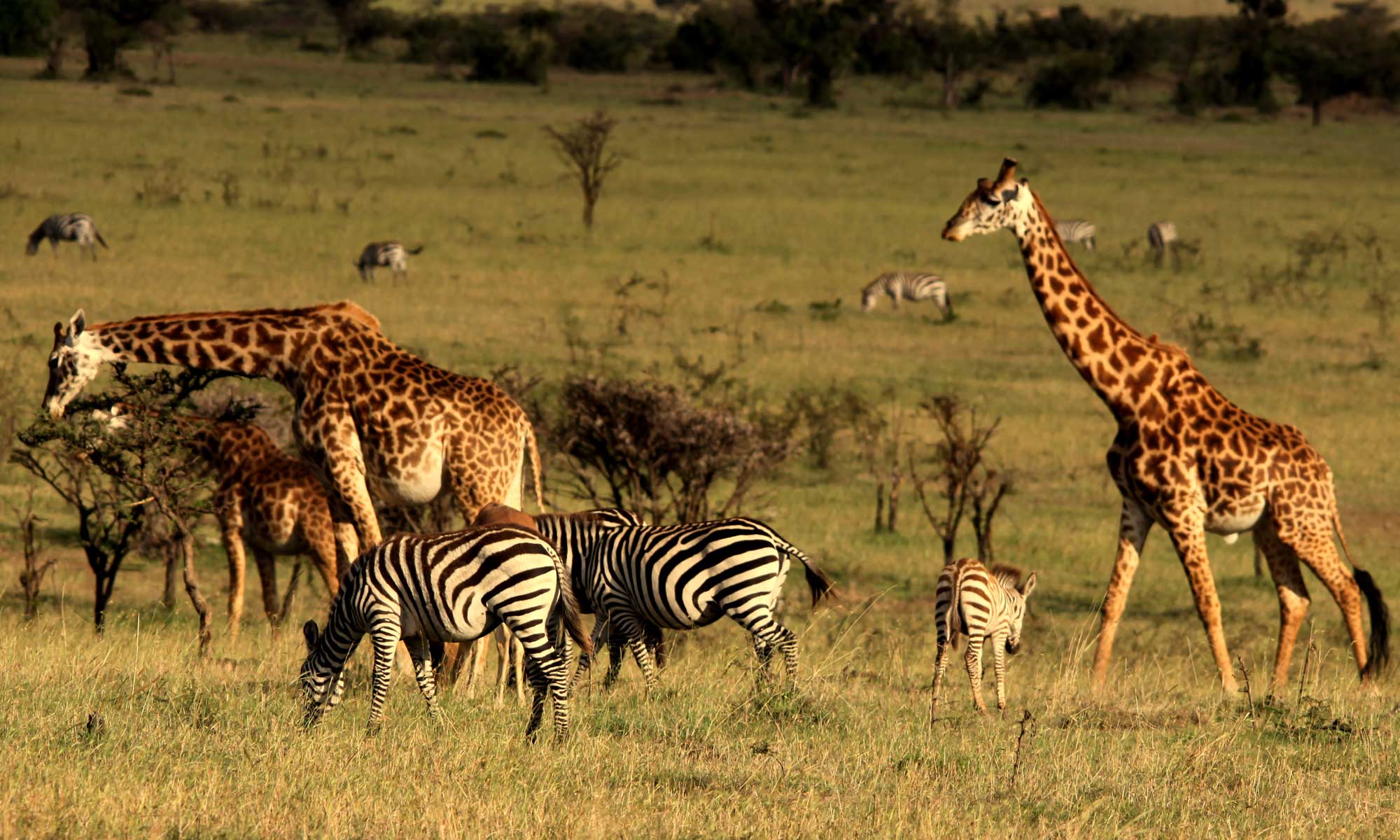
Masai Mara National Park
April 1, 2025The Great Migration in Kenya: A Spectacular Natural Phenomenon
Kenya, a beautiful and diverse country located in East Africa, is one of the world’s most popular tourist destinations. Known for its stunning landscapes, abundant wildlife, rich cultural heritage, and welcoming people, Kenya offers something for everyone, from thrill-seekers to those looking to relax in paradise. Whether you’re an adventure enthusiast, a wildlife lover, or someone simply looking to explore a new culture, Kenya has it all.
Kenya is a country rich in natural beauty, wildlife, and culture, making it a top destination for tourists from around the world. Here are some of the major tourist attractions in Kenya:
The Great Migration in Kenya: A Spectacular Natural Phenomenon
The Great Migration, often referred to as the “greatest wildlife show on Earth,” is one of the most spectacular and awe-inspiring events in the natural world. This annual migration sees millions of wildebeest, zebras, and gazelles travel across the vast plains of East Africa, in a relentless cycle of life, survival, and reproduction. The Great Migration is primarily associated with the Maasai Mara National Reserve in Kenya, but it begins and ends in Tanzania’s Serengeti National Park. The migration, however, is not confined to Kenya alone, as it traverses both countries in an ancient rhythm dictated by the search for food, water, and the instinct to reproduce.
What is the Great Migration?
The Great Migration is the movement of over 1.5 million wildebeest, along with hundreds of thousands of zebras, gazelles, and other herbivores, as they move between the Serengeti in Tanzania and the Maasai Mara in Kenya. The migration is driven by the availability of fresh grazing pastures and water, as the animals are constantly in search of these resources, which shift with the seasons.
Though it is a single movement, the journey is not linear and happens in stages, taking nearly a year to complete. The movement involves crossing various landscapes, including grassy plains, river systems, and the forested hills of the Mara. Along the way, the animals must contend with numerous dangers, not least from predators like lions, cheetahs, hyenas, and crocodiles.
The Stages of the Great Migration in Kenya
The Great Migration is one of the most extraordinary natural events in the animal kingdom, taking place annually in East Africa, primarily in the Serengeti-Maasai Mara ecosystem. Millions of wildebeest, along with zebras and gazelles, travel between the Serengeti National Park in Tanzania and the Maasai Mara National Reserve in Kenya, following an age-old pattern driven by the changing seasons, food availability, and the need to reproduce.
1. Calving Season – Southern Serengeti (January – March)
Key Location: Serengeti, Southern Region
The migration begins in the southern Serengeti, where millions of wildebeest and other grazers congregate to give birth to their young, primarily in February. This is the start of the cycle, and it is vital for the survival of the species. The southern Serengeti, with its nutrient-rich grasslands, is the ideal place for calving, as the newly born calves have a better chance of survival due to the abundant food supply.
This period is crucial because the young calves are vulnerable to predation. Predators, including lions, hyenas, and cheetahs, are very much part of the cycle, with many hunting the newborns. The high concentration of young animals provides a feast for the predators, and this “bottleneck” is a vital part of the natural ecosystem.
1. The Timing of Calving: A Synchronization with Nature
Optimal Timing for Survival
The wildebeest is known for its highly synchronized calving period. Around 500,000 wildebeest are born during the calving season, and the majority of these births occur within a period of just a few weeks—usually from late January through February. This synchronization ensures that the herd’s young calves are born around the same time, providing numerous advantages for the survival of the species:
Safety in Numbers: By calving in large numbers, the wildebeest and other herbivores create a situation in which predators are overwhelmed by the sheer volume of young animals. The “predator confusion” factor means that not all predators can target the weakest or most vulnerable calves.
Increased Protection from Predators: The synchronized births increase the chances of survival for individual calves, as predators like lions, hyenas, and cheetahs can only capture a limited number of animals at once. A high density of calves within a short time span helps provide natural defense mechanisms against predation.
Resource Availability: The timing of calving coincides with the rainy season and the availability of fresh grass in the southern Serengeti. This ensures that there is an ample food supply for both the mothers and the newborns. Calves need to grow quickly to keep up with the herd and avoid predators, and having abundant grazing resources is crucial to their early survival.
2. The Birth Process: A Critical Moment
Labor and the First Moments of Life
The actual process of calving is fairly quick. A female wildebeest will give birth to a single calf after a gestation period of approximately 8-9 months. Unlike many species that give birth alone or in hidden locations, wildebeest and other grazers often give birth in the open, on the vast plains, surrounded by other members of the herd.
Instant Mobility: As soon as a calf is born, it is crucial that it stands up and joins the herd quickly. Wildebeest calves are incredibly precocious, and within minutes of birth, they are able to stand and start walking. This is an essential adaptation because the herds are constantly moving, and the calf must be able to keep up to avoid becoming separated from the group or prey for predators.
Vulnerable Newborns: Newborn calves are weak and unsteady on their feet in the first few moments, making them vulnerable to attacks by predators. However, within hours, most calves are able to walk and follow their mothers, which significantly increases their chances of survival.
Protection by the Herd: The herd provides an essential protective buffer for newborns. Older members of the herd, especially the females, form a protective circle around the young ones, making it difficult for predators to single them out. Wildebeests are highly social animals, and their herd behavior is crucial to the safety of their young.
3. Challenges for the Newborns: A Fight for Survival
Predation and the Harsh Realities of the Plains
While the synchronized births increase the likelihood of some calves surviving, the process of calving comes with many challenges. Predators are a constant threat during this period, and the newborns are particularly vulnerable in the first days and weeks of life.
Lion Attacks: Lions are the primary predators of wildebeest, and they frequently target the youngest and weakest members of the herd. The predators are opportunistic and often lie in wait near the birthing grounds, waiting for a calf to become separated or too slow to keep up with the herd.
Hyena and Cheetah Predation: In addition to lions, hyenas and cheetahs are major predators of wildebeest calves. Hyenas are particularly known for targeting weaker, slower animals that are easier to catch. Cheetahs, being incredibly fast, can catch a young wildebeest that has become separated from its mother.
Crocodile Threat: While the calving takes place away from water sources initially, as the herds start moving and grazing, some calves will cross rivers or streams. At these locations, crocodiles pose a significant threat to the newborns, particularly during river crossings.
Natural Selection at Work
The high level of predation during the calving period serves as a natural mechanism for selection. Only the strongest and most agile calves survive the constant threats from predators, and these are the individuals that will eventually contribute to the future generations of the species. As a result, those that survive the first weeks of life have a significantly higher chance of growing into strong, healthy adults.
4. Post-Calving: Growth and Strengthening
The Importance of Bonding
The bond between mother and calf is incredibly important during the early stages of life. Wildebeest mothers are very protective of their young and will aggressively defend them from predators. The bond ensures that the calf receives the necessary care, nourishment, and protection to grow strong enough to keep up with the herd.
Feeding and Nurturing: For the first few weeks, the calf will rely on its mother’s milk for nourishment. The mother’s milk is rich in nutrients, helping the calf gain weight and strength quickly. The longer a calf stays close to its mother, the better its chances are of surviving.
Gradual Introduction to Grazing: Within the first few weeks of life, calves begin to sample grass and other vegetation, though they primarily rely on milk during the early stages. As they grow stronger and more mobile, they will begin to feed more independently.
5. The Role of Calving in the Greater Ecosystem
Ecological Impact and the Balance of Nature
Calving is a critical event not only for the wildebeest but also for the entire ecosystem. The simultaneous birth of hundreds of thousands of calves provides an abundance of prey for predators, maintaining the balance between herbivores and carnivores in the ecosystem. Additionally, the grazing of large herds of wildebeest helps maintain the health of the grasslands, preventing overgrowth and promoting the regeneration of fresh grasses.
A Cycle of Life
The birth of wildebeest calves marks the beginning of the Great Migration’s cycle. These young animals will grow into the adult herds that will continue the journey northward as they get older. As the young wildebeest mature, they will begin to play a key role in the next generation of migration, participating in the search for food, water, and new grazing grounds.
2. The Herds Move North (April – June)
As the rainy season fades and the grasses in the southern Serengeti are consumed, the wildebeest, zebras, and gazelles begin to move north toward the central Serengeti and the western corridors, in search of new grazing land. The animals travel in massive herds, and their movement is synchronized by the availability of food and the seasonal rains.
During this period, the herds begin to cross the Grumeti River, a dangerous crossing due to the presence of large crocodiles that lie in wait for the migrating animals. The herds press on toward the Masai Mara in Kenya, and this journey can sometimes take several months as the herds move north.
3. Crossing the Mara River (July – October)
The most iconic and dramatic part of the Great Migration is the crossing of the Mara River. This usually occurs between July and October when the herds reach the northern edge of the Serengeti and move into Kenya’s Maasai Mara. The Mara River forms a natural border between the two parks, and the wildebeest must cross it to continue their journey.
At this time, the river is at its fullest, and the crossing becomes one of the most perilous parts of the migration. The wildebeest gather on the banks of the river, hesitant to enter the waters. Once one or a few brave individuals begin the crossing, a mass exodus ensues, with hundreds of thousands of wildebeest plunging into the swift, crocodile-infested waters. The sight of hundreds of wildebeest leaping into the river, only to be snatched by crocodiles, is a dramatic spectacle.
The Mara River crossing is not just about the wildebeest; zebras and gazelles also make the treacherous journey. This event, however, also attracts predators like lions, cheetahs, and hyenas, who shadow the migration, waiting for the weakest or most vulnerable animals to make their move.
4. In the Maasai Mara (July – October)
Once across the Mara River, the herds settle in the Maasai Mara, which has an abundance of fresh grass and water at this time of year. The Mara provides a temporary haven for the herds, and they graze peacefully in the reserve’s lush plains. The animals often remain in the Mara until the start of the short rains around October, before they start the return journey south.
The presence of so many animals in one place attracts not only tourists but also predators. During this period, the animals are at their most vulnerable, with predators like lions and cheetahs hunting the migrating herds. However, it is also a time of relative abundance for the wildlife, as they take advantage of the plentiful resources.
5. Return Journey (November – December)
After spending several months in the Maasai Mara, the wildebeest and their companions begin to move south again towards the Serengeti. This return journey occurs between November and December as the short rains begin to green the southern Serengeti plains. During this time, the herds begin the cycle once again, heading back to their calving grounds in the south to prepare for another season of reproduction.
The migration is an annual, continuous cycle, and it begins anew as soon as the herds arrive back in the southern Serengeti.
Why is the Great Migration Important?
The Great Migration plays a vital role in the ecosystem of the region. It helps maintain the balance of nature in both the Serengeti and Maasai Mara ecosystems. The migration ensures that grazing lands remain healthy, as the movement of these animals prevents overgrazing in one particular area. This movement also stimulates the natural behaviors of predators, keeping predator populations in check and ensuring that only the fittest animals survive.
Furthermore, the migration is a natural spectacle that attracts tourists from all over the world, providing economic benefits to the local communities and conservation efforts. The Maasai Mara and Serengeti regions have become world-famous for safaris, wildlife photography, and witnessing the incredible drama of the Great Migration.
